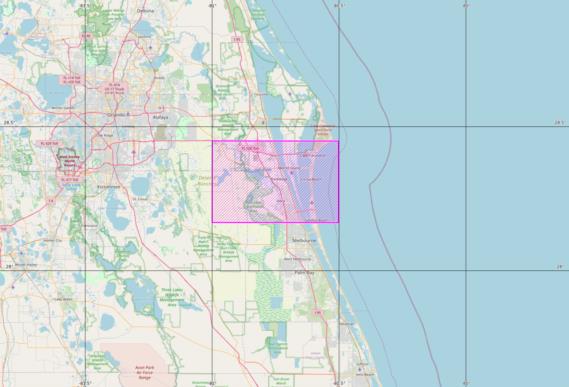
NavList:
A Community Devoted to the Preservation and Practice of Celestial Navigation and Other Methods of Traditional Wayfinding
From: Matus Tejiscak
Date: 2021 Jun 16, 16:06 -0700
Thank you Frank, this was a super nice puzzle.
> can you determine the observer's approximate latitude and longitude, and with what error bars?
My answer is: Cape Canaveral, FL
The resulting position lies between 28°10' N and 28°27' N, and between 80°30' W and 81°00' W. This rectangle contains Cape Canaveral the city (but not really the space centre), and that's the only interesting location in that region. My conclusion is that you entered "Cape Canaveral" into the search bar and the website gave you the city rather than the launch pad. Which is reasonable, after all; most people would want that.
I'm quite confident that the solution cannot lie outside these coordinates, or else the numbers would start rounding to the wrong digits. I carefully tracked all sources of rounding errors generously enough to guarantee the inclusion of the correct answer, even at the expense of decreased precision. If I still got the answer wrong, then it's disappointing but it would also display that there's something that I don't understand, or neglected incorrectly -- which would be exciting in its own way, too.
My approach:
First, the latitude. The length of the day has to round to 13h 55m, which means it's somewhere between 13:54:30 and 13:55:30. If you assume the Nautical Almanac definition of sunrise/sunset (H = -50'), civil twilight (H = -6°), and nautical twilight (H = -12°), then the website numbers agree perfectly (well, up to correct rounding to whole minutes) with the almanac data for latitudes between 28°10' N and 28°27' N on the prime meridian. Outside of these latitudes, rounding will necessarily produce a different figure for the length of the day (the twilight spans are less restrictive), so the latitude cannot be outside these bounds. The final location will likely not lie on the prime meridian but this range already includes wiggle space for a ±12h change in the declination of the Sun so it's fully robust to all longitudes between ±180°, and likely acceptable for exotic time zones, like UTC+14, too.
Second, the longitude. This is trickier. But more interesting, too. Having the length of the day to 1-minute precision does not help us with determining the longitude at all. However, for this latitude band, the Moon lags 54 minutes behind the Sun every 24h. Moonrise occurs 98 minutes after the sunrise in the target location, while it occurs 87 minutes after the sunrise on the prime meridian. This means we're definitely west, and while the rounding errors still permit a wide range of longitudes, we know we can be no more west than 90°W and no more east than 57°W. This is very imprecise but most of this area is in the ocean, except for a small part that intersects Florida.
But this is great, because now we know that Florida uses EDT, which is UTC-4, and thus we know that the TZ centre is 60°W. Sunrise occurs at 06:25 local time, which is 1h 23m ± 1m behind the local time of sunrise on the prime meridian. This places us between 20.5° and 21° W from the TZ centre, i.e. 80°30' W and 81°00' W.
Well, and there is one location with an interesting name in that area, which is Cape Canaveral, FL.
By the way, I have to attribute the "lunar distance" idea to my girlfriend, who came up with it. She didn't even seem to need time to think when I told her I was struggling with the longitude; she suggested right away to look at the difference between the Moon and the Sun. Annoying. :)
> By the way, I'm appalled (appalled!) by the symbology that this website uses for the phases of the Moon. :)
Interesting, can you elaborate, please?







